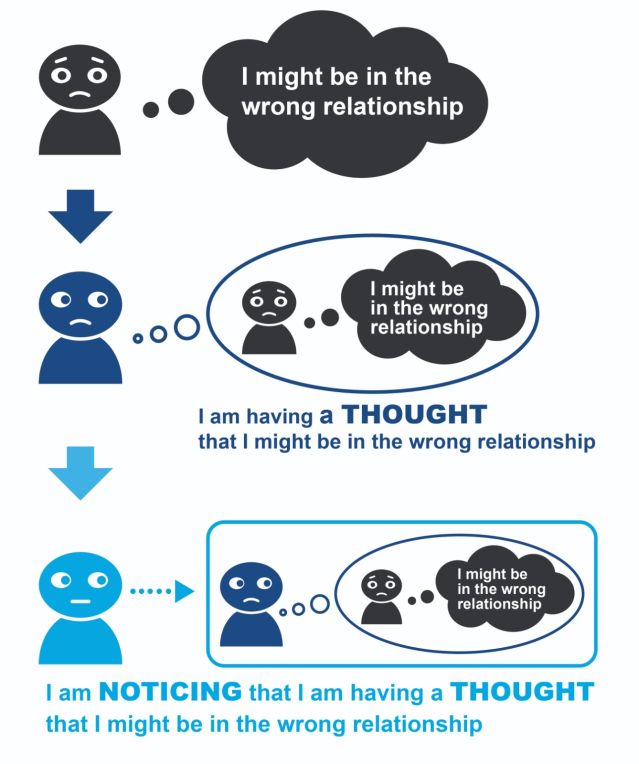OCD
Confronting Your Relationship OCD Fears
Managing exposure and response prevention (ERP) for relationship OCD.
Updated July 15, 2023 Reviewed by Jessica Schrader
Key points
- ROCD is characterized by persistent and distressing doubts regarding one’s romantic relationship or partner.
- In ERP, clients learn to gradually engage with their fears while refraining from resorting to compulsions.
- Although challenging, ERP practice helps clients with ROCD build meaningful, fulfilling relationships.

This post is Part 2 of a two-part series on coping with relationship OCD. Part 1 focused on the recognition of compulsions and triggers and discussed several techniques to support the prevention of engaging in compulsions.
Relationship obsessive-compulsive disorder (ROCD) is a type of obsessive-compulsive disorder (OCD) characterized by intrusive thoughts and compulsions focused on one’s relationship. Individuals with ROCD experience distressing doubts and questions related to their relationship, accompanied by feelings of anxiety, shame, or urgency. They respond to these obsessions with compulsive behaviors or mental acts in an attempt to neutralize their distressing thoughts and alleviate their doubts (Doron et al., 2014).
In a previous post, we discussed the importance of reducing compulsive reactions to obsessions and distressing emotions as a crucial step toward breaking the cycle of ROCD. By reducing the reliance on compulsions, individuals gradually regain control over their attention and mental capacity that was previously consumed by their struggles with unwanted thoughts and feelings (Twohig, 2009).
This process of decreasing engagement in compulsions is called response prevention (i.e., preventing the compulsive response). However, to take recovery a step further, individuals should progress to the next level of training known as exposure and response prevention (ERP).
Exposure and response prevention
ERP is considered the gold-standard treatment for OCD (Hezel & Simpson, 2019; Olatunji et al., 2013). It builds upon response prevention by actively and intentionally exposing individuals to their fears and triggers, allowing them to experience the distressing feelings that arise, while refraining from engaging in compulsions to alleviate those feelings.
At first, ERP may seem confusing to clients who already face anxiety-provoking obsessions regularly and may be weary of feeling the distressing emotions that arise from repeatedly confronting their triggers. However, ERP provides several important benefits:
- Habituation. Allowing anxiety to naturally subside without attempting to escape, reduce, or resolve it (e.g., by using compulsions) helps individuals learn that the distressing feelings gradually diminish by themselves over time (Foa et al., 2012).
- Empowerment and Self-Efficacy. By facing their fears directly, individuals become more resilient in dealing with the unpleasant emotions that accompany them. This gradually enhances their sense of control and self-confidence in managing anxiety, allowing them to feel equipped to deal with a wider range of unpleasant situations and emotions (Jacoby & Abramowitz, 2016).
- Taking Control. ROCD triggers can appear unexpectedly, leading to the overwhelming urge to engage in compulsive behaviors. In ERP, individuals actively choose the time, place, nature, and duration of each exposure, thereby strengthening their control over their obsessions. This proactive approach allows individuals to willingly confront their intrusive thoughts, rather than being “bossed around” by them. In this manner, individuals are actively attentive to their urges to engage in compulsions and are able to prepare themselves to refrain from doing so.
- False-Alarm Recognition. The more we initiate contact with something, the more our mind learns to stop treating it as a threat. Through repeated exposure to triggers that evoke unpleasant thoughts and feelings, individuals help their minds recognize that although the experience may be unpleasant, it does not represent an actual threat or emergency that demands a reaction. Over time, the mind gradually learns to disregard these false alarms (Craske et al., 2014).
ERP for ROCD
When implementing ERP for ROCD, both in vivo exposures and imaginary exposures are considered (Doron & Derby, 2017).
In vivo exposures are planned, real-life scenarios in which the client deliberately confronts their fears and triggers the urge to engage in compulsions. For instance, watching TED Talks by intelligent individuals could serve as exposure for someone fixated on their partner’s intelligence. Viewing unflattering pictures of their partner could be an exposure for someone concerned about their partner’s physical appearance. Watching romantic movies might be an exposure for someone obsessing over making the wrong romantic choice.
In imaginary exposures, individuals purposefully bring to mind distressing thoughts or images that typically trigger compulsions. This could involve writing a script about a feared outcome, such as being stuck in the wrong relationship, and reading it during designated times. Alternatively, intentionally recalling triggering thoughts, words, or images like “I might be in the wrong relationship,” “I have doubts,” or terms like “divorce,” “breakup,” and “commitment,” can be effective exposures.
As previously described, several techniques support response prevention during ERP. These techniques include refocusing attention from obsessions to the external world, mindfully acknowledging thoughts and feelings without engaging with them, and postponing interactions with intrusive thoughts to specific, allocated times.
One effective ERP technique involves deliberately bringing to mind a distressing thought, such as “I might be in the wrong relationship,” and focusing on it for a short time without resorting to compulsions. Then, we reframe the thought by acknowledging “I am having a thought that I might be in the wrong relationship,” and shortly after taking it a step further by adding “I am noticing that I am having a thought that I might be in the wrong relationship.” Subsequently, attention can be redirected to the present moment, whether it be a conversation, a meal, or a work task, despite any unpleasant feelings or urges to delve back into the thought.

This practice allows us to confront a triggering thought and transform our relationship with it. Instead of seeing the thought as something to avoid, struggle with, resolve, or eliminate, we acknowledge it as a passing mental occurrence among many others. By simply noticing and labeling our thoughts, we create distance between ourselves and the thoughts, and regain the ability to disengage from them.
Planning and managing ERP
ERP work can sometimes be challenging for individuals struggling with ROCD. Therefore, therapy plans for ERP exercises should be designed incrementally, starting with less-challenging exposures, and gradually progressing to more difficult ones as the individual’s ability to confront triggering content strengthens. In addition, it is important to plan ahead of time when and where to undertake ERP exercises, rather than having a vague intention to practice ERP when suitable, as this provides a sense of control and improves compliance.
During ERP practice, it is imperative to prioritize response prevention and resist the temptation to engage in compulsions such as comparing one’s partner to others, monitoring one’s feelings towards their partner, or endlessly deliberating about the suitability of the relationship. Engaging in compulsions during or after the exposure reinforces the ROCD cycle.
Although ERP may be challenging, consistent practice can help individuals break free from the grip of ROCD and allows for the cultivation of meaningful and fulfilling relationships. Working with an OCD specialist can significantly aid in the process of planning, engaging in, and sustaining ERP work.
To learn more about Relationship OCD, click here.
To find a therapist, visit the Psychology Today Therapy Directory.
References
Craske, M. G., Treanor, M., Conway, C. C., Zbozinek, T., & Vervliet, B. (2014). Maximizing exposure therapy: An inhibitory learning approach. Behaviour research and therapy, 58, 10–23.
Doron, G., & Derby, D. (2017). Assessment and Treatment of Relationship‐Related OCD Symptoms (ROCD) A Modular Approach. The Wiley handbook of obsessive-compulsive disorders, 1, 547–564.
Doron, G., Derby, D. S., & Szepsenwol, O. (2014). Relationship obsessive compulsive disorder (ROCD): A conceptual framework. Journal of Obsessive-Compulsive and Related Disorders, 3(2), 169–180.
Foa, E. B., Yadin, E., & Lichner, T. K. (2012). Exposure and response (ritual) prevention for obsessive-compulsive disorder: Therapist guide. Oxford University Press.
Hezel, D. M., & Simpson, H. B. (2019). Exposure and response prevention for obsessive-compulsive disorder: A review and new directions. Indian journal of psychiatry, 61(Suppl 1), S85.
Jacoby, R. J., & Abramowitz, J. S. (2016). Inhibitory learning approaches to exposure therapy: A critical review and translation to obsessive-compulsive disorder. Clinical Psychology Review, 49, 28–40.
Olatunji, B. O., Davis, M. L., Powers, M. B., & Smits, J. A. (2013). Cognitive-behavioral therapy for obsessive-compulsive disorder: A meta-analysis of treatment outcome and moderators. Journal of psychiatric research, 47(1), 33–41.
Twohig, M. P. (2009). The application of acceptance and commitment therapy to obsessive-compulsive disorder. Cognitive and Behavioral Practice, 16(1), 18–28.




